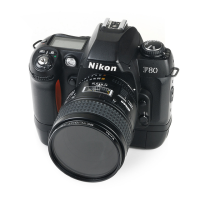62
Auto Exposur
Auto Exposur
e Bracketing
e Bracketing
—continued
—continued
Multiple Exposur
Multiple Exposur
e
e
Exposure
• Rotating the Sub-Command Dial while pressing the Auto Exposure
Bracketing button ¸ changes the setting as follows:
Number of shots and
compensated EV value
Bracketing bar graphs Bracketing order
3F 0.5 0, –0.5, +0.5
3F 1.0 0, –1.0, +1.0
3F 1.5 0, –1.5, +1.5
3F 2.0 0, –2.0, +2.0
@2F 0.5 0, +0.5
@2F 1.0 0, +1.0
@2F 1.5 0, +1.5
@2F 2.0 0, +2.0
^2F 0.5 0, –0.5
^2F 1.0 0, –1.0
^2F 1.5 0, –1.5
^2F 2.0 0, –2.0
3
Compose picture, focus and shoot.
• Compensated shutter speed and aperture values are displayed during
shooting.
• To cancel the Bracketing, rotate the Main-Command Dial while pressing the
¸ button so z disappears from the LCD panel or perform Two-Button
Reset (page 76). The number of shots and compensated EV values
previously selected will remain when they are cancelled with the Main-
Command Dial, and they automatically reset to “3F 0.5” when the Two-
Button Reset is performed.
• If the exposure compensation function (page 60) or flash exposure
compensation (page 85) is also set, Bracketing will be combined with the
exposure compensation values. It is useful to perform Bracketing with a
compensated value of over +2 EV or under –2 EV.
• With film advance mode in ˜ (continuous shooting), fully depress and hold
the shutter release button until the set number of shots has been taken and
film advance stops automatically.
• If the end of the film roll is reached during Bracketing, the remaining shots
can be taken after new film has been loaded. Also, if you turn the power
switch off during Bracketing, the remaining shots can be taken after the
power is turned back on.
• Bracketing is performed with one frame at a time when the self-timer (page
68) is set.
2
Rotate the Main-Command Dial while pressing the ∆
button to set the necessary exposure compensation.
• Test shooting is recommended since the compensation actually required
varies depending on the shooting situation.
• When the background is completely dark and subjects do not overlap, no
compensation is necessary for each shot.
• In some cases, frames may shift slightly in multiple exposure. In particular,
film advance becomes unstable at the beginning and near the end of a film
roll so multiple exposure is not recommended.
• Multiple exposure consists of two or more exposures of one or more
subjects in the same frame. Multiple exposure can be performed in any
of the available exposure modes.
1
Rotate and set the film advance mode selector to Z
while pressing the film advance mode selector lock
release.
• Z appears in the viewfinder.
63
Standard compensation value in Multiple exposure
Exposure compensation is
necessary depending on the
number of exposures in
Multiple exposure since
more than one image is
exposed in the same frame.
Number of exposures Compensation value
Two –1.0 EV
Three –1.5 EV
Four –2.0 EV
Eight or Nine –3.0 EV
c 3: Bracketing order can be set to change from negative EV value to
positive EV value (page 71).
F80 (E)-Thailand 02.12.27 5:21 PM Page 62

